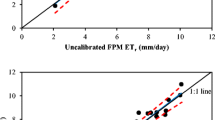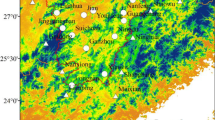Abstract
Precise estimation of reference evapotranspiration (ETo) is one of the most influential factors in proper irrigation scheduling and water resources management. Over the years, various methods and formula have been developed to estimate ETo based on several required variables and assumptions. Accuracy and performance of different ETo estimation equations applied for open field differ from those under controlled greenhouse conditions. Considering the microclimate condition of greenhouses, local calibration is required to choose the best and the most accurate method. This study aimed to investigate the performance of different ETo simulation models including one combination, one temperature-based and seven radiation-based methods under the greenhouse conditions. First, computational methods were calibrated by regression analysis. Then, the accuracy of ETo simulation models was compared with that of micro-lysimeter measurements. Statistical indices including coefficient of determination (R2), mean bias error (MBE), root mean square error (RMSE), relative root mean square error (RRMSE) and index of agreement (d) were used for validation and verification. Finally, the general ranking among the models was conducted using the standardized Ranking Performance Index (sPRI). According to the results, Penman–Monteith method with a fixed aerodynamic resistance of 53 s m−1 (with 0.98, − 0.01 mm day−1, 0.07 mm day−1, 0.80% and 0.99 for R2, MBE, RMSE, RRMSE and d statistical indices, respectively) was the best and the most precise method for estimating ETo under greenhouse conditions. Turc method, with a cumulative difference of 24.01 mm during the whole simulation period (73 days), underestimated ETo the most under the same conditions.



Similar content being viewed by others
References
Abedi-Koupai J, Amiri MJ, Eslamian SS (2009) Comparison of artificial neural network and physically based models for estimating of reference evapotranspiration in greenhouse. Aust J Basic Appl Sci 3(3):2528–2535
Abtew W (1996) Evapotranspiration measurements and modeling for three wetland systems in South Florida. J Am Water Resour Assoc 32(3):465–473
Alexandris S, Kerkides P, Liakatas A (2006) Daily reference evapotranspiration estimates by the ‘‘Copais’’ approach. Agric Water Manag 82:371–386
Alexandris S, Stricevic R, Petkovic S (2008) Comparative analysis of reference evapotranspiration from the surface of rainfed grass in central Serbia, calculated by six empirical methods against the Penman–Monteith formula. Eur Water 21(22):17–28
Algharibi E, Schmitz G, Lennartz F, Schutze N, Grundmann J, Kloss S (2013) Evaluation of field and greenhouse experiments with tomatoes using the aquacrop model as a basis for improving water productivity. In: Assessment of Climate Change Impact on Water Resources in Serbia, pp 560–575
Allen RG (2005) The ASCE standardized reference evapotranspiration equation. American Society of Civil Engineers, Reston
Allen RG, Pereira LS, Raes D, Smith M (1998) Crop evapotranspiration: guidelines for computing crop requirements, FAO Irrigation and Drainage Paper no. 56. FAO, Rome
Anapalli SS, Ahuja LR, Gowda PH, Liwang M, Marek G, Evett SR, Howell TA (2016) Simulation of crop evapotranspiration and crop coefficients with data in weighing lysimeters. Agric Water Manag 177:274–283
Aschonitis VG, Lekakis E, Tziachris P, Doulgeris C, Papadopoulos F, Papadopoulos A, Papamichail D (2019) A ranking system for comparing models performance combining multiple statistical criteria and scenarios: the case of reference evapotranspiration models. Environ Modell Softw 114:98–111
Baille M, Baille A, Laury JC (1994) A simplified model for predicting evapotranspiration rate of nine ornamental species vs. climate factors and leaf. Acta Hortic 59:217–232
Brutsaert W (1982) Evaporation in the atmosphere: theory, history, and application. Springer, Berlin
Çakir R, Kanburoglu-Çebi U, Altintas S, Ozdemir A (2017) Irrigation scheduling and water use efficiency of cucumber grown as aspring-summer cycle crop in solar greenhouse. Agric Water Manag 180:78–87
Conversa G, Bonasia A, Di Gioia F, Elia A (2015) A decision support system (GesCoN) for managing fertigation in vegetable crops: part II model calibration and validation under different environmental growing conditions on field grown tomato. Front Plant Sci 6:495. https://doi.org/10.3389/fpls.2015.00495
Efthimiou N, Alexandris S, Karavitis C, Mamassis N (2013) Comparative analysis of reference evapotranspiration estimation between various methods and the FAO56 Penman-Monteith procedure. Eur Water 42:19–34
Fernández MD, Bonachela S, Orgaz F, Thompson R, López JC, Granados MR, Gallardo M, Fereres E (2010) Measurement and estimation of plastic greenhouse reference evapotranspiration in a Mediterranean climate. Irrig Sci 28:497–509. https://doi.org/10.1007/s00271-010-0210-z
George BA, Reddy BRS, Raghuwanshi NS, Wallender WW (2002) Decision support system for estimating reference evapotranspiration. J Irrig Drain Eng 128(1):1–10
Gruda N (2005) Impact of environmental factors on product quality of greenhouse vegetables for fresh consumption. Crit Rev Plant Sci 24:227–247
Hargreaves GH, Samani ZA (1985) Reference crop evapotranspiration from temperature. Appl Eng Agric 1(2):96–99
Irmak S, Irmak A, Allen RG, Jones JW (2003) Solar and net radiation-based equations to estimate reference evapotranspiration in humid climates. J Irrig Drain Eng 129:336–347
Jamieson PD, Porter JR, Wilson DR (1991) A test of computer simulation model ARC-WHEAT1 on wheat crops grown in New Zealand. Field Crops Res 27:337–350
Jensen ME, Haise HR (1963) Estimation of evapotranspiration from solar radiation. J Irrig Drain Div 89:15–41
Jensen ME, Burman RD, Allen RG (1990) Evapotranspiration and irrigation water requirements: ASCE Manual no 70. ASCE, New York
Katsoulas N, Stanghellini C (2019) Modelling crop transpiration in greenhouses: different models for different applications. Agronomy 9:392
Kisi O (2014) Comparison of different empirical methods for estimating daily reference evapotranspiration in Mediterranean climate. J Irrig Drain Eng 140:04013002
Libardi L, Faria R, Dalri A, Rolim G, Palaretti L (2018) High precision weighing lysimeters for evapotranspiration measurements of sugarcane pre-sprouted plantlets. Engenharia Agrícola 38(2):208–216
Liu XY, Xu CY, Zhong XL, Li YZ, Yuan XH, Cao JF (2017) Comparison of 16 models for reference crop evapotranspiration against weighing lysimeter measurement. Agric Water Manag 184:145–155
Lopez-Urrea R, de Santa M, Olalla F, Fabeiro C, Moratalla A (2006) Testing evapotranspiration equations using lysimeter observations in a semiarid climate. Agric Water Manag 85(1–2):15–26
Luo Y, Jiang Y, Peng S, Khan S, Cai X, Wang W, Jiao X (2012) Urban weather data to estimate reference evapotranspiration for rural irrigation management. J Irrig Drain Eng 138(9):837–842
Makkink GF (1957) Testing the Penman formula by means of lysimeters. J Institu Water Eng 11:277–288
Mao X, Mengyu L, Xinyuan W, Changming L, Shi ZH (2003) Effects of deficit irrigation on yield and water use of greenhouse grown cucumber in the North China Plane. Agric Water Manag 61(3):219–228
Martínez-Cob A, Tejero-Juste M (2004) A wind-based qualitative calibration of the Hargreaves ET0 estimation equation in semiarid regions. Agric Water Manag 6:251–264
McKenney MS, Rosenberg NJ (1993) Sensitivity of some potential evapotranspiration estimation methods to climate change. Agr Fores Meteorol 64:81–110
Monteith JL, Unsworth MH (1990) Principles of environmental physics. Academic Press, London
Morille B, Migeon C, Bournet PE (2013) Is the Penman-Monteith model adapted to predict crop transpiration under greenhouse conditions? Application to a New Guinea Impatiens crop. Sci Hortic 152:80–91
Muniandy JM, Yusop Z, Askari M (2016) Evaluation of reference evapotranspiration models and determination of crop coefficient for Momordica charantia and Capsicum annuum. Agric Water Manag 169:77–89
Pandey P, Dabral P, Pandey V (2016) Evaluation of reference evapotranspiration methods for the northeastern region of India. Int Soil Water Conserv Res 4:52–63
Peng L, Li Y, Feng H (2017) The best alternative for estimating reference crop evapotranspiration in different sub-regions of mainland China. Sci Rep 7(1):1–19
Penman HL (1948) Natural evaporation from open water, bare and grass. Proc R Soc Lond Ser A 193:120–145
Qiu RJ, Kang SZ, Du TS, Tong L, Hao XM, Chen RQ, Chen JL, Li FS (2013) Effect of convection on the Penman-Monteith model estimates of transpiration of hot pepper grown in solar greenhouse. Sci Hortic 160:163–171
Rahimikhoob A, Behbahani M, Fakheri J (2012) An evaluation of four reference evapotranspiration models in a subtropical climate. Water Resour Manag 26(10):2867–2881
Razzaghi F, Sepaskhah A (2012) Calibration and validation of four common ETo estimation equations by lysimeter data in a semi-arid environment. Arch Agron Soil Sci 58(3):303–319. https://doi.org/10.1080/03650340.2010.518957
Samaras DA, Reif A, Theodoropoulos K (2014) Evaluation of radiation-based reference evapotranspiration models under different mediterranean climates in Central Greece. Water Resour Manag 28(1):207–225
Santhi C, Arnold JG, Williams JR, Dugas WA, Srinivasan R, Hauck LM (2001) Validation of SWAT model on a large river basin with point and nonpoint source. Wiley, New Jersey
Stanghellini C (2014) Horticultural production in greenhouses: efficient use of water. Acta Hortic 1034:25–32
Takakura T, Kubota C, Sase S, Hayashi M, Ishii M, Takayama K, Nishina H, Kurata K, Giacomelli GA (2009) Measurement of evapotranspiration rate in a single-span greenhouse using the energy-balance equation. Biosys Eng 102:298–304
Trajkovic S (2005) Temperature-based approaches for estimating reference evapotranspiration. J Irrig Drain Eng 131(4):316–323
Turc L (1961) Estimation of irrigation water requirements, potential evapotranspiration: a simple climatic formula evolved up to date. Ann Agron 12:13–49
Tüzel Y, Leonardi C (2009) Protected cultivation in Mediterranean Region: trendsand needs. Ege Üniv Ziraat Fak Derg 46:215–223
Valiantzas JD (2013) Simple ET0 forms of Penman’s equation without wind and/or humidity data. I: theoretical development. J Irrig Drain Eng 139(1):1–8
Villarreal-Guerrero F, Kacira M, Fitz-Rodríguez E, Kubota C, Giacomelli GA, Linker R, Arbel A (2011) Comparison of three evapotranspiration models for a greenhouse cooling strategy with natural ventilation and variable high pressure fogging. Sci Hortic 134:210–221
Willmott CJ (1981) On the validation of models. Phys Geogr 2:184–194
Willmott CJ (1982) Some comments on the evaluation of model performance. Bull Am Meteorol Soc 63:1309–1313
WWAP (2019) The United Nations World Water Development Report 2019: leaving no one behind. UNESCO, Paris
Yan H, Zhang C, Coenders-Gerrits M, Acquah SJ, Zhang H, Wu H, Zhao B, Huang S, Fu H (2018) Parametrization of aerodynamic and canopy resistances for modeling evapotranspiration of greenhouse cucumber. Agric For Meteorol 262:370–378. https://doi.org/10.1016/j.agrformet.2018.07.020
Yoder RE, Odhiambo LO, Wright WC (2005) Evaluation of methods for estimating daily reference crop evapotranspiration at a site in the humid southeast US. Appl Eng Agric 21:197–202
Zeleke K, Wade L (2012) Evapotranspiration estimation using soil water balance, weather and crop data. In: Irmak A (ed) Evapotranspiration: remote sensing and modeling. In-Tech, Croatia. https://doi.org/10.5772/17489
Zhang L, Lemeur R (1992) Effect of aerodynamic resistance on energy balance and Penman-Monteith estimates of evapotranspiration in solar greenhouse conditions. Agric For Meteorol 58(3–4):209–228
Acknowledgement
The authors gratefully acknowledge the financial support from the Iran National Science Foundation (INSF) [research project No.96013073].
Author information
Authors and Affiliations
Corresponding author
Ethics declarations
Conflict of interest
The authors declare no conflict of interest.
Additional information
Publisher's Note
Springer Nature remains neutral with regard to jurisdictional claims in published maps and institutional affiliations.
Rights and permissions
About this article
Cite this article
Rahimikhoob, H., Sohrabi, T. & Delshad, M. Assessment of reference evapotranspiration estimation methods in controlled greenhouse conditions. Irrig Sci 38, 389–400 (2020). https://doi.org/10.1007/s00271-020-00680-5
Received:
Accepted:
Published:
Issue Date:
DOI: https://doi.org/10.1007/s00271-020-00680-5




